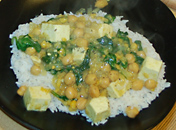Selection and Storage
Spinach is at its peak during the winter season. When selecting spinach at the market, opt for fresh leaves that exhibit a deep green color, vibrancy, and crisp texture. Avoid those with dull or sunken leaves, yellowing, or spots.
Upon bringing spinach home, thoroughly wash the leaves under clean running water and rinse them in saltwater for approximately 30 minutes to eliminate any dirt or residues from insecticides.
Although spinach can be stored in the refrigerator for up to a week, it’s best to consume fresh leaves as soon as possible to maximize their nutritional benefits.
Preparation and serving methods
Prior to using the leaves in cooking, rinse them under cold water. Gently dry them by patting with a tissue or soft cloth. Remove any tough stems by trimming. Raw leaves can be chopped or utilized whole in a multitude of recipes.

|
| Spinach-rice with chickpeas and tofu. Photo courtesy: scottfeldstein |

|
| Palak-paneer. Thoroughly cooked spinach leaves mashed, sauteed and mixed with paneer) cubes. |
Here are some serving tips:
-
Fresh, tender spinach leaves (baby spinach) can be enjoyed raw in salads, vegetable burgers, or as juice. However, it’s worth noting that their antioxidant properties may decrease significantly when subjected to steaming, frying, or prolonged boiling.
-
Spinach leaves are commonly incorporated alongside other vegetables or mushrooms in dishes such as noodles, pies, pasta, pilaf (pulao), and soups. They are also used in the preparation of baby foods.
-
You can create Mediterranean-style dishes like spinach soufflé, casseroles, lasagna, quiche, and spinach-filled tortellini using spinach.
-
In India and Pakistan, where spinach is known as “palak,” it features in various delicious dishes such as “palak paneer” (a dish made with Indian cottage cheese), aloo-palak (with potatoes), fried rice, chicken, and meat preparations.
-
In India and Bangladesh, spinach is often combined with other seasonal greens like goosefoot (Chenopodium album), fenugreek, mustard greens, and Malabar spinach (Basella alba) to create “saag,” which is typically served with unleavened bread (roti) or rice.
Safety profile
-
Reheating leftover spinach can lead to the conversion of nitrates into harmful nitrites and nitrosamines by certain bacteria. These compounds, prevalent in pre-prepared nitrate-rich foods like spinach and various green vegetables, may pose health risks, particularly for children.
-
The presence of phytates and dietary fiber in spinach leaves could hinder the absorption of essential minerals such as iron, calcium, and magnesium.
-
Spinach, rich in vitamin K, is advised to be avoided by individuals taking anti-coagulants like “warfarin” due to its potential interference with drug metabolism.
-
Oxalic acid, a naturally occurring substance in certain vegetables like spinach, may crystallize as oxalate stones in the urinary tract for some people. Those with known oxalate urinary tract stones are recommended to steer clear of vegetables from the Amaranthaceae and Brassica family, ensuring adequate water intake to maintain normal urine output.
-
Spinach might also contain goitrogens, which can disrupt thyroid hormone production, potentially causing thyroxin hormone deficiency in individuals with thyroid dysfunction
Also read ≻≻-
≻≻- Arugula (Salad rocket) Nutrition facts.
≻≻- Lamb’s lettuce (Mâche) Nutrition facts.
≺≺ Back to Vegetables from Spinach nutrition. Visit here for an impressive list of vegetables with complete illustrations of their nutrition facts and
health benefits.
≺≺ Back to Home page.
Further reading:
-
Refer Vegetable information page – University of Illinois Extension. (Link opens in new window).
-
USDA National Nutrient Database.(Link opens new window)
-
Vegetables Oxalate- Oxalosis and Hyperoxaluria Foundation.